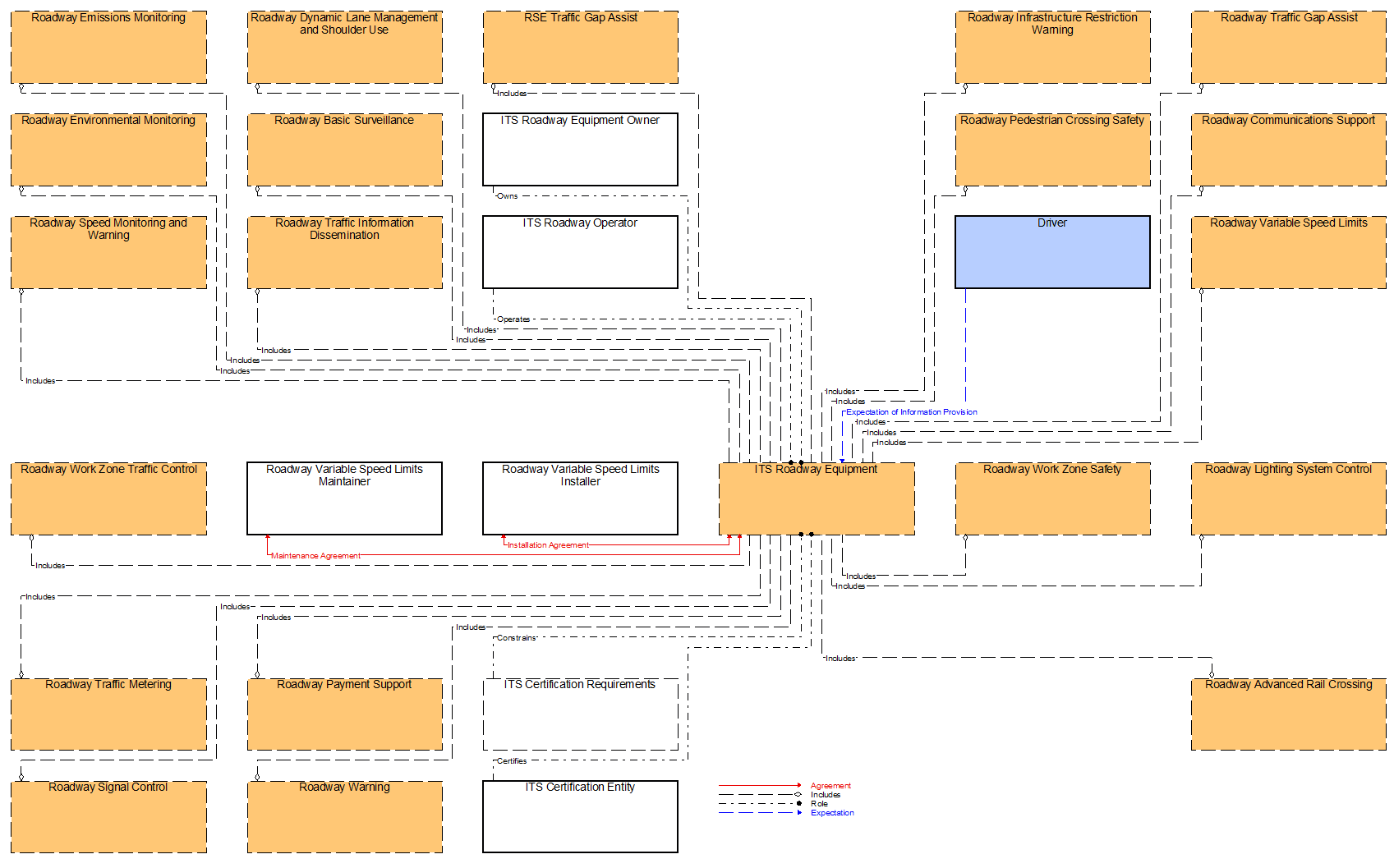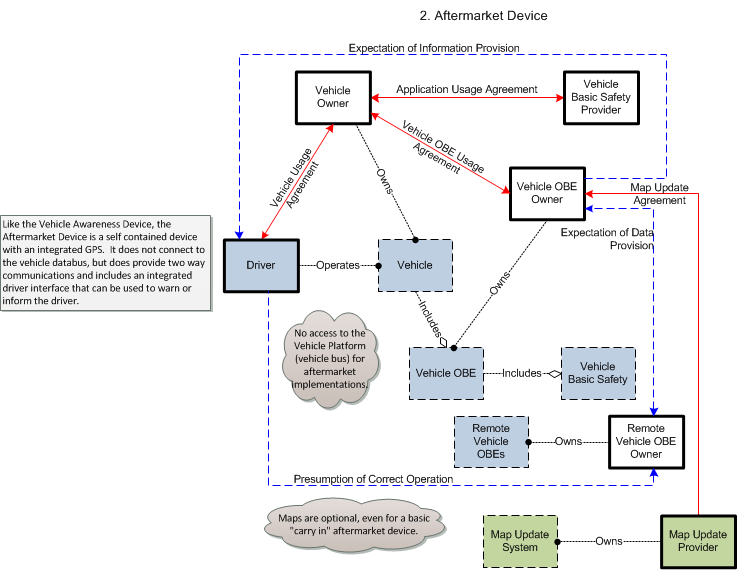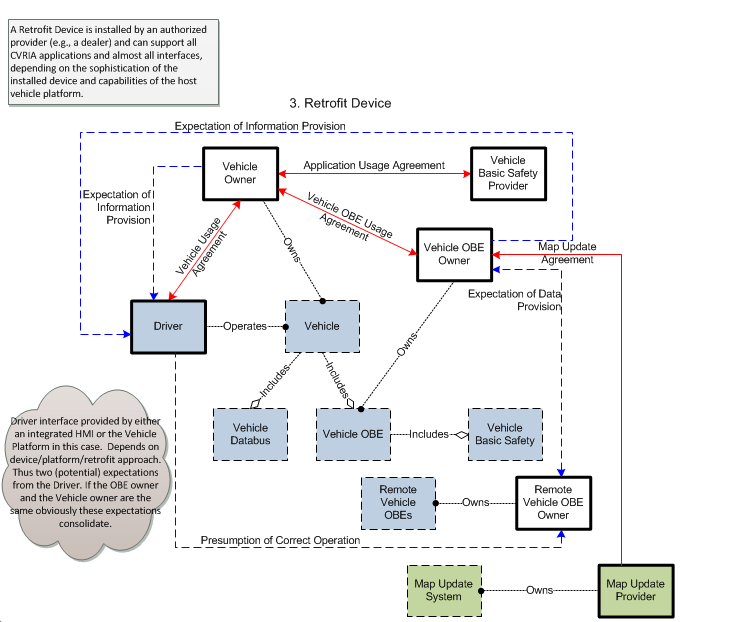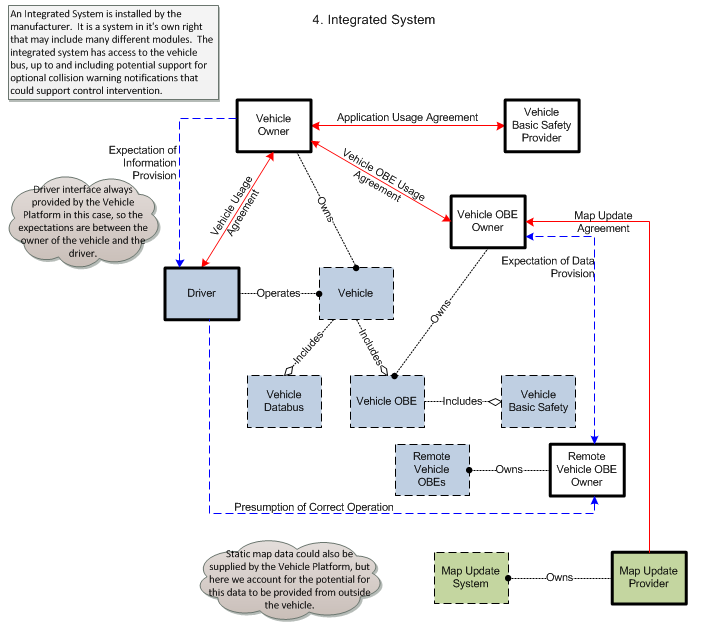Type: Resource
ITS Roadway Equipment
Overview
'ITS Roadway Equipment' represents the ITS equipment that is distributed on and along the roadway that monitors and controls traffic and monitors and manages the roadway itself. In CVRIA, this physical object represents all of the other ITS field equipment that interfaces with and supports the Connected Vehicle Roadside Equipment (RSE). This physical object includes traffic detectors, environmental sensors, traffic signals, highway advisory radios, dynamic message signs, CCTV cameras and video image processing systems, grade crossing warning systems, and ramp metering systems. Lane management systems and barrier systems that control access to transportation infrastructure such as roadways, bridges and tunnels are also included. This object also provides environmental monitoring including sensors that measure road conditions, surface weather, and vehicle emissions. Work zone systems including work zone surveillance, traffic control, driver warning, and work crew safety systems are also included.
This resource is related to the "ITS Roadway Equipment" physical object.
This resource is included in the following applications:
- Cooperative Adaptive Cruise Control
- Core Authorization
- Curve Speed Warning
- Data Distribution
- Eco-Approach and Departure at Signalized Intersections
- Eco-Cooperative Adaptive Cruise Control
- Eco-Lanes Management
- Eco-Ramp Metering
- Eco-Speed Harmonization
- Eco-Traffic Signal Timing
- Eco-Transit Signal Priority
- Emergency Vehicle Preemption
- Enhanced Maintenance Decision Support System
- Freight Signal Priority
- Incident Scene Work Zone Alerts for Drivers and Workers
- Intelligent Traffic Signal System
- Intermittent Bus Lanes
- Low Emissions Zone Management
- Oversize Vehicle Warning
- Pedestrian in Signalized Crosswalk Warning
- Pedestrian Mobility
- Queue Warning
- Railroad Crossing Violation Warning
- Red Light Violation Warning
- Reduced Speed Zone Warning / Lane Closure
- Restricted Lane Warnings
- Road Weather Information and Routing Support for Emergency Responders
- Road Weather Information for Freight Carriers
- Road Weather Motorist Alert and Warning
- Roadside Lighting
- Speed Harmonization
- Spot Weather Impact Warning
- Stop Sign Gap Assist
- Stop Sign Violation Warning
- Transit Signal Priority
- Transit Vehicle at Station/Stop Warnings
- Variable Speed Limits for Weather-Responsive Traffic Management
- Vehicle Data for Traffic Operations
- Warnings about Hazards in a Work Zone
- Warnings about Upcoming Work Zone
Coordination
Security
Interfaces Diagram

Alternative Configurations
Four diagrams below illustrate four different implementations that may be represented by the Vehicle On-Board Equipment: 1) Vehicle Awareness Device, 2) Aftermarket Device, 3) Retrofit Device, or 4) Integrated System. Each diagram shows the subset of interfaces from CVRIA that are relevant to that particular implementation. Note that a V2V safety application is shown, but the four implementation options also provide varied support for other connected vehicle applications. Map provider shown as it is a likely interface for many safety applications, and the different points at which the map hooks in are illustrative of changes in necessary relationships. A fifth diagram covers a scenario where an aftermarket carry-in device is carried in to a vehicle that is already equipped with one of the Vehicle OBE implementations.
1. Vehicle Awareness Device – This is an aftermarket electronic device, installed in a vehicle without connection to vehicle systems, that is only capable of sending the basic safety message over short range communications. Vehicle awareness devices do not issue audible or visual warnings, alerts, or guidance to the driver of the vehicle.
2. Aftermarket Device – This is an aftermarket electronic device, installed in a vehicle, and capable of sending and receiving messages over a wireless communications link. The self-contained device includes GPS, runs connected vehicle applications, and includes an integrated driver interface that issues audible or visual warnings, alerts, and guidance to the driver of the vehicle. The aftermarket device may or may not have access to some vehicle system status.
3. Retrofit Device – This is an OEM authorized electronic device installed in vehicles by an OEM authorized service provider, at a service facility after the vehicle has been built. This type of device provides two-way communications and is connected to a vehicle databus. Depending on implementation, the device may include an integrated driver interface and GPS or integrate with modules on the vehicle databus that provide these services. Depending on implementation, it may only support some of the connected vehicle applications identified in CVRIA and potentially support additional applications that are not identified in CVRIA.
4. Integrated System – This is a system of one or more electronic devices integrated into vehicles during vehicle production. The Integrated System is connected to proprietary data busses to share information with other on-board systems. The Integrated System may be distributed across multiple subsystems and may be configured to support some of the connected vehicle applications identified in CVRIA and potentially support additional applications that are not identified in CVRIA.
In retrofit and integrated implementations, the Vehicle OBE interfaces to other on-board systems through a vehicle databus (e.g., CAN). Represented in CVRIA as the Vehicle Databus, this interface provides access to on-board sensors, monitoring and control systems, and information systems that support connected vehicle applications. The vehicle databus may also be the source for GPS location and time, map data that supports connected vehicle applications, and the access point for the vehicle's driver-vehicle interface.
5. A fifth diagram covers a scenario where an aftermarket carry-in device is carried in to a vehicle that is already equipped with one of the Vehicle OBE implementations. In this scenario, we have two different devices with possibly two different radios and two different user interfaces that must be coordinated to avoid interference or conflicts.